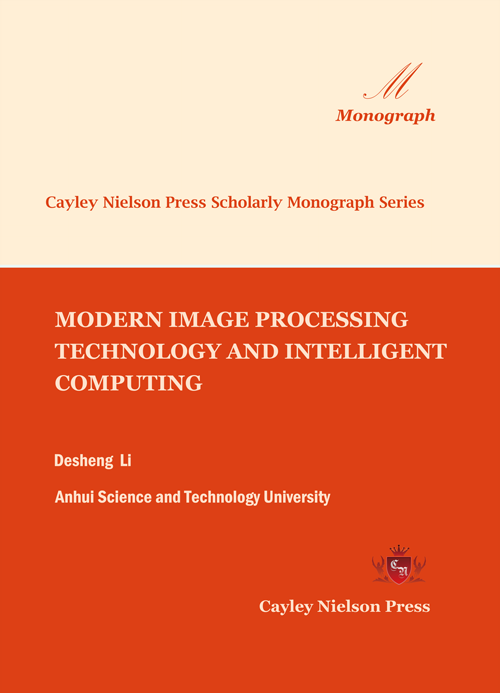
MODERN IMAGE PROCESSING TECHNOLOGY AND INTELLIGENT COMPUTING

Desheng Li
Anhui Science and Technology University
Copyright © 2017 by Cayley Nielson Press, Inc.
ISBN: 978-0-9992443-9-5
Cayley Nielson Press Scholarly Monograph Series Book Code No.: 140-2-2
US$150.50
Preface
Recently, novel theories, methods and equipment about image technology are immerging with the upgrading of the rapid development of computer technology and the image capture device. Especially, image technology based on intelligence has been more widely used in many areas, such as multimedia technology, accurate measurements, non-destructive testing, medical image analysis, biometric image recognition, moving object detection, SAR image target detection, accurate positioning of the missile.
In this monograph, the author proposes some novel algorithms with medical images, street view and map system. Most of them involves the swarm intelligence algorithm, level set method, calculus of variations and random walk.
The author is supported financially by Natural Science Foundation of Anhui Province (1708085MF161), KeyProject of Supporting Program for Outstanding Young Talents in Universities of 2016 (Gxyqzd2016214), Key Project of Natural Science Research of Universities in Anhui (KJ2015A236), the Natural Science Foundation of Anhui Province (No. 1308085QF103), the Natural Science Foundation of Educational Government of Anhui Province (No. KJ2013B073), the Science and Technology Plan Project of Chuzhou City (No. 201236), and the Talent Introduction Special Fund of Anhui Science and Technology University (No. ZRC2011304), and was partially supported by grants of Natural Science Foundation of Anhui province (No. 1508085MC55), Key Project from Education Department of Anhui Province (No. KJ2013A076).
Desheng Li
Dr. Associate Professor
College of Information & Networking Engineering
Anhui Science and Technology University
Fengyang, Anhui, China
May 12, 2017
Contents
Preface............................................................................................................................................ I
1 Design of Two-Dimensional Recursive IIR Filters Using Cooperative Quantum Particle Swarm Optimization with Dynamic Varying Search Area and Lévy Flights........... 7
1.1 Introduction....................................................................................................................... 7
1.2 Formulation of optimized design of 2-D IIR digital filter....................... 9
1.3 CQPSO with Dynamic Varying Search Area (DVSA) and Lévy flights.... 13
1.3.1 Rationale of Dynamic Varying Search Area (DVSA).................................. 13
1.3.2 Condition of DVSA........................................................................................................ 15
1.3.3 Policy of population scale adjustment......................................................... 16
1.3.4 Theoretical analysis................................................................................................. 17
1.4. Lévy flights....................................................................................................................... 19
1.5 Proposed algorithm - CQPSO-DVSA-LFD................................................................. 21
1.5.1 Particle representation........................................................................................ 21
1.5.2 Position update strategy....................................................................................... 22
1.5.3 Equation of particle motion............................................................................... 23
1.5.4 Steps of proposed approach.................................................................................. 23
1.6 Experimental results.................................................................................................. 25
1.6.1 Preliminary test on function optimization benchmark..................... 25
1.6.2 Results of 2-D IIR digital filter example....................................................... 26
1.7 Conclusions........................................................................................................................ 32
2 Level Set Medical Image Segmentation Aided by Cooperative Quantum Particle Optimization with Lévy Flights................... 34
2.1 Introduction..................................................................................................................... 34
2.2 Model Review.................................................................................................................... 38
2.2.1. Review of Level Set Method................................................................................ 38
2.2.2. Formalization of LBF Model................................................................................ 39
2.2.3 LBF Algorithm................................................................................................................ 43
2.3 Particle swarm optimization (CQPSO-LF) CQPSO-LF aided LBF Algorithm 44
2.3.1 CQPSO-LF Algorithm.................................................................................................... 44
2.3.2. CQPSO-LF aided LBF Algorithm............................................................................. 49
2.4 Experimental results and analysis..................................................................... 52
2.5 Conclusions and future work................................................................................. 66
3 Cooperative Particle Swarm Optimizer in Permutation Flow Shop Scheduling Problem 67
3.1 Introduction..................................................................................................................... 67
3.2 Flowchart of proposed approach for medical image stitching........ 69
3.3 Proposed Novel Parallel SIFT (NPSIFT) feature detective algorithm 71
3.3.1 Review on original SIFT features detective algorithm...................... 71
3.3.2 NPSIFT algorithm......................................................................................................... 73
3.4 Transformation fitting optimization............................................................... 81
3.4.1 Problem description................................................................................................. 81
3.4.2 Transformation parameters sub-optimization........................................ 82
3.4.3 Point matching sub-optimization...................................................................... 84
3.4.3.1 CQPSO-LF algorithm................................................................................................. 84
3.4.3.2 Fitness function and representation of particle position........... 86
3.4. Transformation fitting optimization algorithm..................................... 87
3.5 Experiments and discussions.................................................................................... 89
3.5.1 Performance of CQPSO-LF........................................................................................ 89
3.5.2 Validation of the proposed medical image stitching approach..... 91
3.5.3 A comparative analysis on the retinal fundus image stitching... 100
3.5.3 Overall performance of the proposed method.................................... 114
3.6 Conclusion........................................................................................................................ 115
4 Real-time Carpooling System on Android Terminal using SIP and LBS Service 116
4.1 Introduction.................................................................................................................. 116
4.2 System Architecture.................................................................................................. 117
4.2.1 Component Diagram................................................................................................ 117
4.2.2 System Module Diagram........................................................................................ 119
4.2.3 Main Flowchart of the whole Carpooling Method............................ 122
4.3 An Instance for this Invention............................................................................ 122
4.4 The Approach of Query the Nearby Persons in Server........................... 131
4.4.1 The Distance between Two Points in the System.................................. 131
4.4.2 Stored Procedure Approach of Query the Persons Nearby in Server 132
4.5. Implementation........................................................................................................... 134
4.5.1 Acquisition of the Nearby Data Module Work Steps........................... 134
4.5.2 User Position Locating Work Steps................................................................. 134
4.5.3 The Principle of Labeling User on Baidu Map............................................ 134
4.6 Conclusion........................................................................................................................ 141
5 Publishing Copyrighted Watermarking Video with Locational Information 142
5.1 Introduction.................................................................................................................. 142
5.2 Open Problems................................................................................................................ 145
5.3 Prior Art............................................................................................................................ 146
5.4 Implementation............................................................................................................ 147
5.4.1 Notations...................................................................................................................... 147
5.4.2 System architecture............................................................................................... 149
5.4.3 Data format................................................................................................................. 152
5.4.4 Location signing and embedding procedure............................................ 152
5.4.5 Location signature verifying and extracting procedure............... 155
5.4.6 Location signature embedding algorithm............................................... 156
5.4.7 Location signature extracting algorithm............................................... 157
5.4.8 Method to encode copyright watermark layer................................... 157
5.4.9 Method to decode copyright watermark layer................................... 164
5.4.10 Implement of stack and array structure of copyright watermark layers 165
5.4.11 Sketch abstracting method............................................................................. 170
5.5 Conclusion........................................................................................................................ 170
6 A Street View Navigating Method Based on Image Tracking of Local Static Objects by Mobile Device................................... 171
6.1 Introduction.................................................................................................................. 171
6.2 Open Problems................................................................................................................ 175
6.3 Prior Art............................................................................................................................ 176
6.4 System Implementation............................................................................................ 178
6.4.1 System architecture............................................................................................... 178
6.4.2 Exchanging data structure................................................................................ 179
6.4.3 Implementation of navigating operation method............................. 182
6.4.4 Default standard navigating schemes........................................................ 196
6.5.5 Navigating scheme handover algorithm................................................... 198
6.6 Conclusion........................................................................................................................ 199
References.............................................................................................................................. 200
Readership
This book should be useful for students, scientists, engineers and professionals working in the areas of optoelectronic packaging, photonic devices, semiconductor technology, materials science, polymer science, electrical and electronics engineering. This book could be used for one semester course on adhesives for photonics packaging designed for both undergraduate and graduate engineering students.
